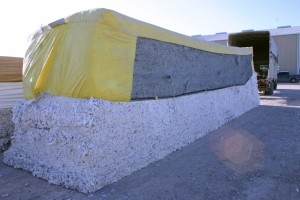by Rod Santa Ana, AgriLife Communications

A cotton module is delivered to the Buddy Ross Cotton Gin north of Mercedes during the peak of last year's South Texas cotton harvest. (AgriLife Communications photo by Rod Santa Ana)
WESLACO – As South Texas farmers battle the elements to produce cotton, grain sorghum and corn this summer, they’ll have an old friend to rely on: a newsletter called Pest Cast.
While some copies are still mailed out, the decades-old publication is now mostly distributed online, a cooperative effort between the Texas AgriLife Extension Service and the Cotton and Grain Producers of the Lower Rio Grande Valley.
It keeps hundreds of growers and others informed about current field conditions, weather events, insect populations and anything else that might impact crop yields, according to newsletter editor John Norman.
“My involvement with Pest Cast started back in April of 1975,” said Norman, a retired AgriLife Extension entomologist and now a private crop consultant.
“Back then the Extension entomologist was a man named Jimmy Deere,” he said. “But I’ve got copies of similar IPM (integrated pest management) newsletters that go back to 1948, written by folks no longer with us, like Andy White and Herman Mayeaux.”
The newsletter has a readership that extends beyond growers, and beyond the four-county Valley area, Norman said.
“Cotton brokers, buyers, consultants, … there are lots of people, not just farmers, who are interested in what’s going on down here,” he said.
Norman is currently writing this year’s third edition of the newsletter.
“This week’s Pest Cast will include information on last week’s rain and hail event, which affected cotton fields in Willacy County,” he said. “Plants were 8- to 12-inches high, and in half a dozen to a dozen fields, those plants were completely knocked down. There were no stalks left in the field.”
Fortunately, Norman said, the hail event was not area-wide.
“Other fields got less hail damage and will recover. Some fields got hit, others didn’t. And in some fields only part of the crop was affected. But chances for recovery will depend on future moisture and how much fertilizer is left in the field, because excessive rain can take nitrogen out of the soil.”
Another tidbit of information in the upcoming issue is the fact that cotton acreage is down significantly this year.
“We’ll have about 70,000 fewer acres in the Valley than we did last year,” Norman said. “Last year we had about 200,000 acres; this year we’ll probably have 130,000 acres,” Norman said.
What wasn’t planted in cotton will likely be planted in grain sorghum, a shift that can be blamed on sagging cotton prices and rising grain prices, Norman said.
“Growers were getting just over $1 per pound of lint last year,” he said. “This year the price is expected to be somewhere between 80 cents and 85 cents per pound,” he said.
Grain prices went the other way, he said.
“Typically, growers get $3 to $4 per hundredweight of grain sorghum,” Norman said. “This year prices are up to between $10 and $12, so lots of growers made the switch from cotton to grain sorghum. It’s only a guess, but I’d estimate we’ll have about 400,000 acres of grain sorghum planted in the Valley this year.”
To subscribe to Pest Cast, call the Texas AgriLife Research and Extension Center at 956-968-5581, or email d12south@ag.tamu.edu . Both online and mailed subscriptions are free.